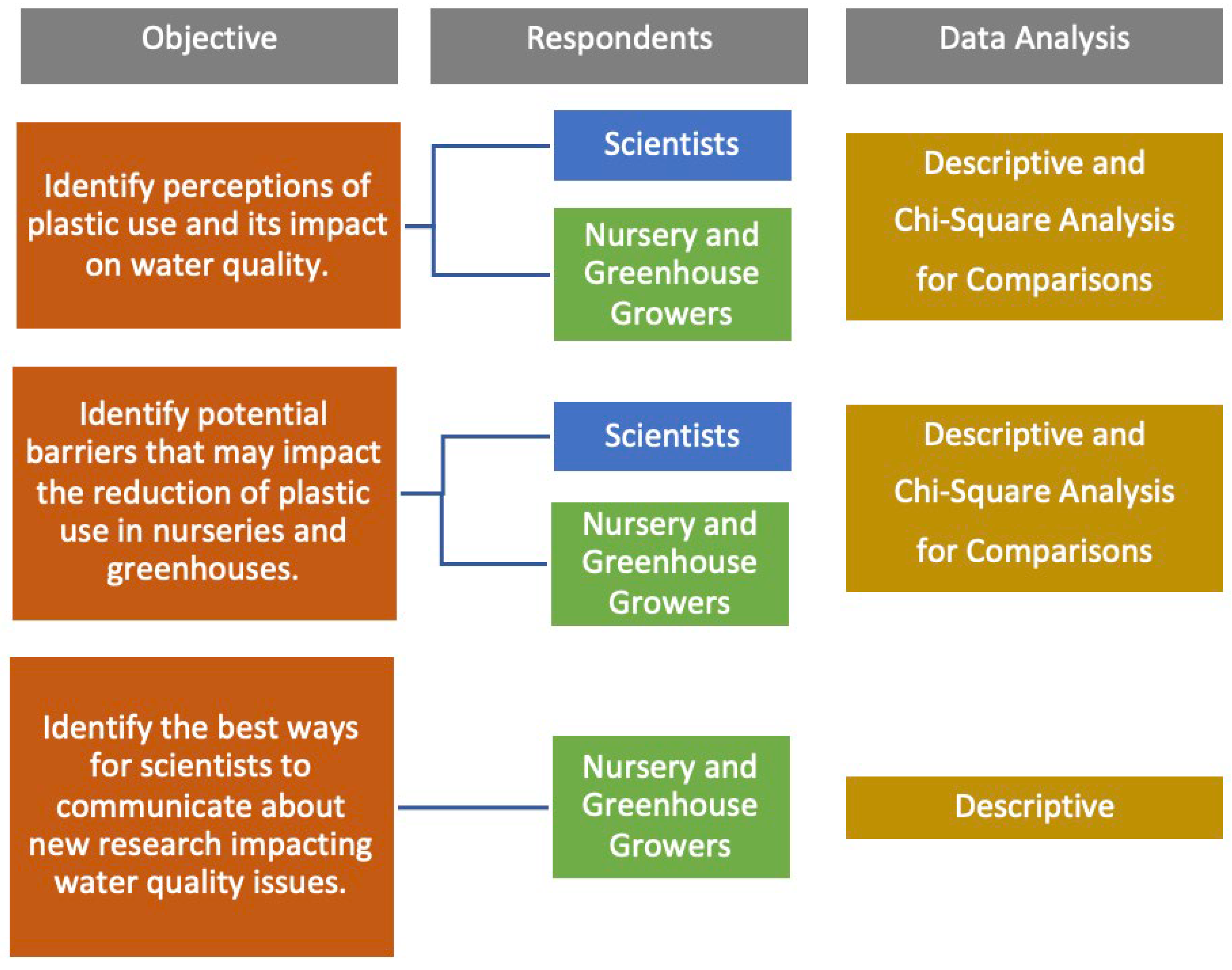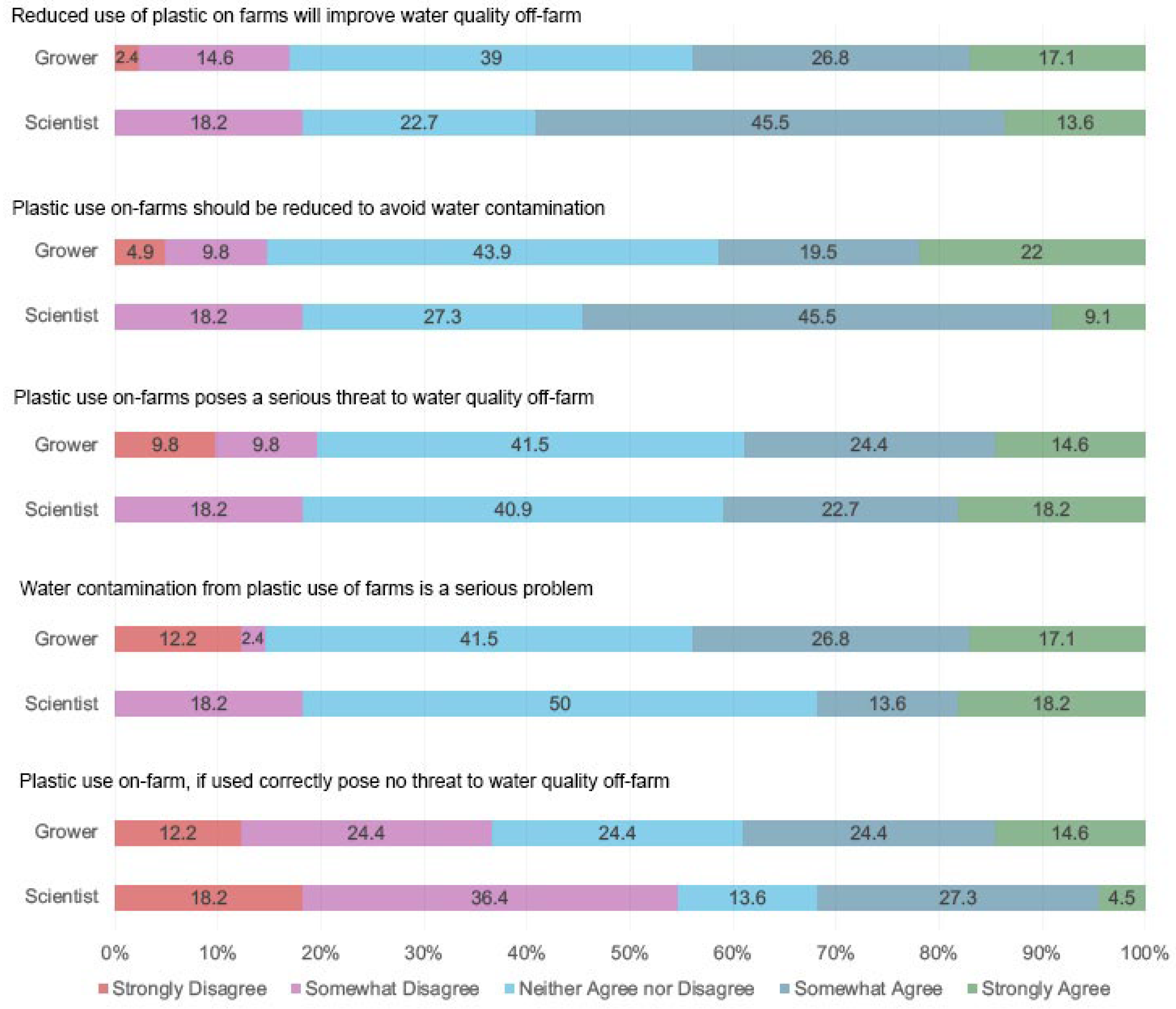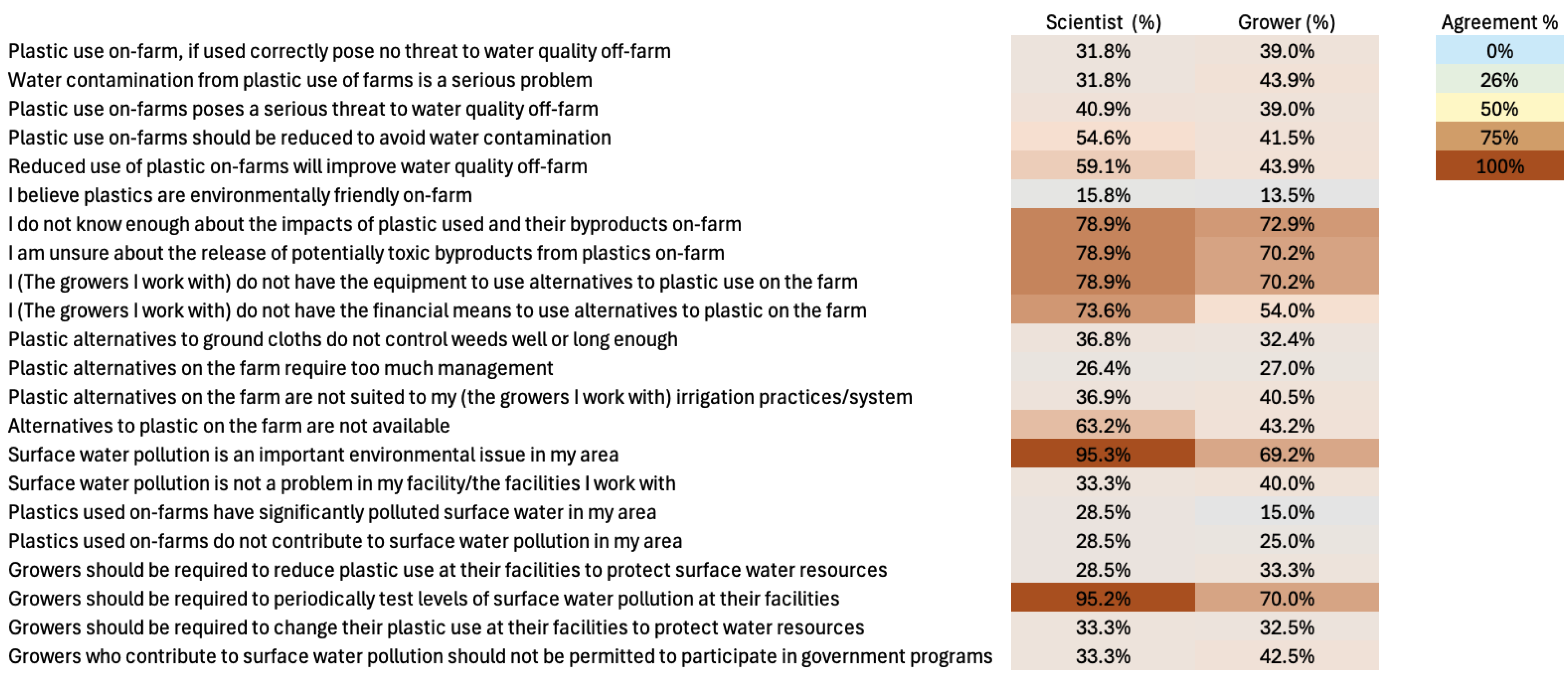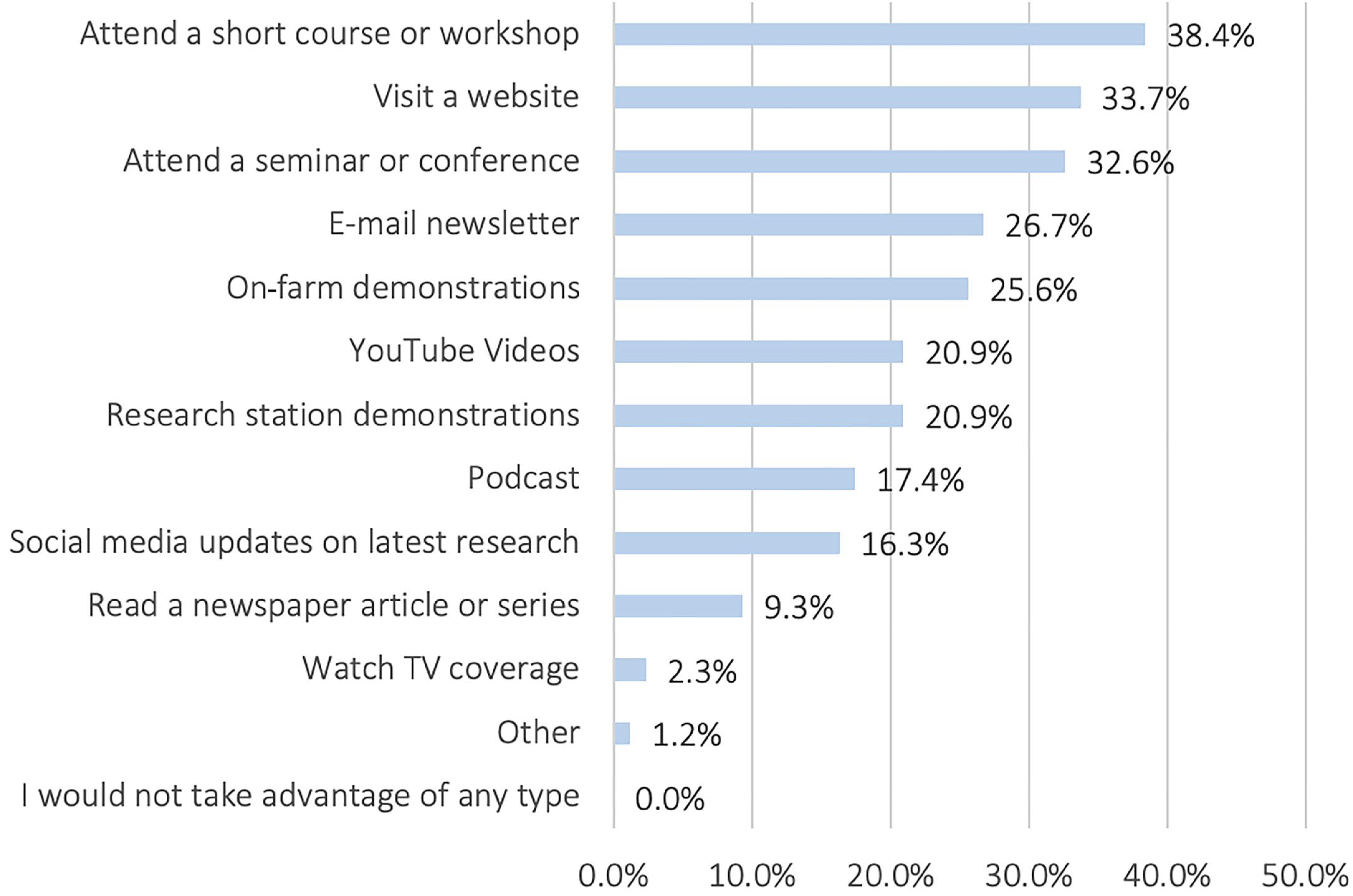A Survey Analysis Comparing Perceptions of Plastic Use in Nurseries and Greenhouses in the United States
Abstract
1. Introduction
2. Materials and Methods
2.1. Study Populations
2.2. Instrumentation
2.3. Data Analysis
3. Results
4. Discussion
5. Conclusions
Author Contributions
Funding
Data Availability Statement
Acknowledgments
Conflicts of Interest
Abbreviations
| PFAS | Per- and Poly-fluoroalkyl substances |
| US | United States |
| USDA | United States Department of Agriculture |
References
- United States Department of Agriculture; National Agricultural Statistics Service. 2017 Census of Agriculture: 2019 Census of Horticultural Specialties. (AC-17-SS-3). 2020. Available online: https://www.nass.usda.gov/Publications/AgCensus/2017/Online_Resources/Census_of_Horticulture_Specialties/HORTIC.pdf (accessed on 28 June 2025).
- Dong, X.; Li, J.; Xu, N.; Lei, J.; He, Z.; Zhao, L. A novel phenology-based index for plastic-mulched farmland extraction and its application in a typical agricultural region of China using Sentinel-2 imagery and Google Earth Engine. Land 2024, 13, 1825. [Google Scholar] [CrossRef]
- Yi, Y.; Shi, M.; Gao, M.; Zhang, G.; Xing, L.; Zhang, C.; Xie, J. Comparative study on object-oriented identification methods of plastic greenhouses based on Landsat Operational Land Imager. Land 2023, 12, 2030. [Google Scholar] [CrossRef]
- Thompson, R.C.; Courtene-Jones, W.; Boucher, J.; Pahl, S.; Raubenheimer, K.; Koelmans, A.A. Twenty years of microplastic pollution research—What have we learned? Science 2024, 386, eadl2746. [Google Scholar] [CrossRef] [PubMed]
- Hua, Z.; Zhang, T.; Luo, J.; Bai, H.; Ma, S.; Qiang, H.; Guo, X. Internalization, physiological responses and molecular mechanisms of lettuce to polystyrene microplastics of different sizes: Validation of simulated soilless culture. J. Hazard. Mater. 2024, 462, 132710. [Google Scholar] [CrossRef]
- Thornton Hampton, L.M.; Bouwmeester, H.; Brander, S.M.; Coffin, S.; Cole, M.; Hermabessiere, L.; Mehinto, A.C.; Miller, E.; Rochman, C.M.; Weisberg, S.B. Research recommendations to better understand the potential health impacts of microplastics to humans and aquatic ecosystems. Microplastics Nanoplastics 2022, 2, 18. [Google Scholar] [CrossRef]
- Bonifazi, G.; Francesconi, E.; Gasbarrone, R.; Palmieri, R.; Serranti, S. A preliminary study on the utilization of hyperspectral imaging for the on-soil recognition of plastic waste resulting from agricultural activities. Land 2023, 12, 1934. [Google Scholar] [CrossRef]
- Wang, C.; Zhao, J.; Xing, B. Environmental source, fate, and toxicity of microplastics. J. Hazard. Mater. 2021, 407, 124357. [Google Scholar] [CrossRef]
- Forman, R.T.T.; Godron, M. Landscape Ecology; John Wiley & Sons: New York, NY, USA, 1986. [Google Scholar]
- Pickett, S.T.A.; Cadenasso, M.L. Landscape ecology: Spatial heterogeneity in ecological systems. Science 1995, 269, 331–334. [Google Scholar] [CrossRef]
- United States Environmental Protection Agency. PFAS Strategic Roadmap: EPA’s Commitments to Action 2021–2024; US Environmental Protection Agency: Washington, DC, USA, 2021; EPA-100-K-21-002. [Google Scholar]
- Modoi, C.; Dascal, D.; Roba, C.; Bale, R. On the importance of public views regarding the environmental impact of plastic pollution in Cluj County, Romania. In Proceedings of the 22nd International Multidisciplinary Scientific GeoConference, Albena, Bulgaria, 4–10 July 2022. [Google Scholar] [CrossRef]
- Donley, N.; Cox, C.; Bennett, K.; Temkin, A.M.; Andrews, D.Q.; Naidenko, O.V. Forever pesticides: A growing source of PFAS contamination in the environment. Environ. Health Perspect. 2024, 132, 075003. [Google Scholar] [CrossRef]
- United States Environmental Protection Agency. Inert Ingredients Overview and Guidance. 2023. Available online: https://www.epa.gov/pesticide-registration/inert-ingredients-overview-and-guidance (accessed on 28 June 2025).
- Alexandrino, D.A.; Almeida, C.M.R.; Mucha, A.P.; Carvalho, M.F. Revisiting pesticide pollution: The case of fluorinated pesticides. Environ. Pollut. 2022, 292, 118315. [Google Scholar] [CrossRef]
- Ogawa, Y.; Tokunaga, E.; Kobayashi, O.; Hirai, K.; Shibata, N. Current contributions of organofluorine compounds to the agrochemical industry. iScience 2020, 23, 101467. [Google Scholar] [CrossRef] [PubMed]
- Wang, Y.; Good, K.D. Microplastics and PFAS air-water interaction and deposition. Sci. Total Environ. 2024, 954, 176247. [Google Scholar] [CrossRef] [PubMed]
- Yazdi, M.N.; Owen, J.S.; Lyon, S.W.; White, S.A. Specialty crop retention reservoir performance and design considerations to secure quality water and mitigate non-point source runoff. J. Clean. Prod. 2021, 321, 128925. [Google Scholar] [CrossRef]
- White, S.A.; Owen, J.; Majsztrik, J.C.; Oki, L.R.; Fisher, P.R.; Lea-Cox, J.D.; Fernandez, R.T. Greenhouse and nursery water management characterization and research priorities in the USA. Water 2019, 11, 2338. [Google Scholar] [CrossRef]
- Fenton, S.E.; Ducatman, A.; Boobis, A.R.; DeWitt, J.C.; Lau, C.; Ng, C.A.; Smith, J.S.; Roberts, S.M. Per- and Polyfluoroalkyl substance toxicity and human health review: Current state of knowledge and strategies for informing future research. Environ. Toxicol. Chem. 2020, 40, 606–630. [Google Scholar] [CrossRef]
- National Toxicology Program. Monograph on Immunotoxicity Associated with Exposure to Perfluorooctanoic Acid (PFOA) and Perfluorooctane Sulfonic Acid (PFOS). Triangle Park: National Toxicology Program. Research. 2016. Available online: https://ntp.niehs.nih.gov/ntp/ohat/pfoa_pfos/pfoa_pfosmonograph_508.pdf (accessed on 28 June 2025).
- Sunderland, E.M.; Hu, X.C.; Dassuncao, C.; Tokranov, A.K.; Wagner, C.C.; Allen, J.G. A review of the pathways of human exposure to poly- and perfluoroalkyl substances (PFASs) and present understanding of health effects. J. Expo. Sci. Environ. Epidemiol. 2018, 29, 131–147. [Google Scholar] [CrossRef]
- Potamac River Basin Partnership. PFAS in the Potomac River Basin. 2025. Available online: https://potomacdwspp.org/priority-issues/pfas-in-the-potomac-river-basin/ (accessed on 28 June 2025).
- Georgia Water Coalition. PFAS Contamination in the Upper and Middle Coosa Basins. 2025. Available online: https://www.arcgis.com/apps/dashboards/6651242f360f4bc98ace448838aa5a8c (accessed on 28 June 2025).
- Breitmeyer, S.E.; Williams, A.M.; Duris, J.W.; Eicholtz, L.W.; Shull, D.R.; Wertz, T.A.; Woodward, E.E. Per- and polyfourinated alkyl substances (PFAS) in Pennsylvania surface waters: A statewide assessment, associated sources and land-use regulations. Sci. Total Environ. 2023, 888, 164161. [Google Scholar] [CrossRef]
- Soares, J.; Machado, A.A.; Gonçalves, F.J.M. Public views on plastic pollution: Knowledge, perceived impacts, and pro-environmental behaviours. Sci. Total Environ. 2021, 755, 142867. [Google Scholar] [CrossRef]
- Jha, G.; Kankarla, V.; McLennon, E.; Pal, S.; Sihi, D.; Dari, B.; Diaz, D.; Nocco, M. Per- and Polyfluoroalkyl Substances (PFAS) in integrated crop–livestock systems: Environmental exposure and human health risks. Int. J. Environ. Res. Public Health 2021, 18, 12550. [Google Scholar] [CrossRef]
- Richter, L.; Cordner, A.; Brown, P. Non-stick science: Sixty years of research and (in)action on fluorinated compounds. Soc. Stud. Sci. 2018, 48, 691–714. [Google Scholar] [CrossRef]
- King, C.D.; Stephens, C.G.; Lynch, J.P.; Jordan, S.N. Farmers’ attitudes towards agricultural plastics: Management and disposal awareness, and perceptions of the environmental impacts. Sci. Total Environ. 2023, 859, 160955. [Google Scholar] [CrossRef] [PubMed]
- Abadi, B. Impact of attitudes, factual and causal feedback on farmers’ behavioral intention to manage and recycle agricultural plastic waste and debris. J. Clean. Prod. 2023, 399, 136611. [Google Scholar] [CrossRef]
- Calloway, E.E.; Chiappone, A.; Schmitt, H.J.; Sullivan, D.; Gerhardstein, B.; Tucker, P.; Rayman, J.; Yaroch, A.L. Exploring Community Psychosocial Stress Related to Per- and Poly-Fluoroalkyl Substances (PFAS) Contamination: Lessons Learned from a Qualitative Study. Int. J. Environ. Res. Public Health 2020, 17, 8706. [Google Scholar] [CrossRef] [PubMed]
- Yazdanpanah, M.; Zobeidi, T.; Mirzaei, A.; Lohr, K.; Warner, L.A.; Lamm, A.J.; Seiber, S. Comparison of different modern irrigation system adopters through socio-economic, innovation characteristics and social capital values. Reg. Environ. Chang. 2023, 23, 152. [Google Scholar] [CrossRef]
- Lamm, A.J.; Warner, L.A.; Gibson, K.E.; Lamm, K.W.; Fisher, P.; White, S.A. A theoretical comparison of nursery and greenhouse growers’ water conservation and water treatment technology adoption in the United States. Acta Hortic. 2022, 1373, 213–222. [Google Scholar] [CrossRef]
- Lamm, A.J.; Warner, L.A.; Tidwell, A.S.D.; Lamm, K.W.; White, S.A.; Fisher, P. Testing an adoption decision-making model of nursery and greenhouse growers’ water reuse in the United States. Water 2019, 11, 2470. [Google Scholar] [CrossRef]
- Ary, D.; Jacobs, L.; Irvine, C.S.; Walker, D. Introduction to Research in Education; Wadsworth, Cengage Learning: Belmont, CA, USA, 2014. [Google Scholar]
- Creswell, J.W. Research Design: Qualitative, Quantitative, and Mixed Methods Approaches, 3rd ed.; Sage Publications, Inc.: Thousand Oaks, CA, USA, 2009. [Google Scholar]
- Tekman, M.B.; Walther, B.A.; Peter, C.; Gutow, L.; Bergmann, M. Impacts of Plastic Pollution in the Oceans on Marine Species, Biodiversity and Ecosystems; Zenodo: Geneva, Switzerland, 2022; Available online: https://zenodo.org/records/5898684 (accessed on 28 June 2025).
- Bottari, T.; Mghili, B.; Gunasekaran, K.; Mancuso, M. Impact of Plastic Pollution on Marine Biodiversity in Italy. Water 2024, 16, 519. [Google Scholar] [CrossRef]
- U.S. Environmental Protection Agency (EPA). Determination of Selected Per- and Polyfluorinated Alkyl Substances in Drinking Water by SPE and LC/MS/MS (EPA Method 537.1); 2025. Available online: https://cfpub.epa.gov/si/si_public_record_report.cfm?Lab=NERL&dirEntryId=343042 (accessed on 28 June 2025).
- Rochman, C.M.; Cook, A.M.; Koelmans, A.A. Plastic debris and policy: Using current scientific understanding to invoke positive change. Environ. Toxicol. Chem. 2016, 35, 1617–1626. [Google Scholar] [CrossRef]
- Rochman, C.M. Microplastics research—From sink to source. Science 2018, 360, 28–29. [Google Scholar] [CrossRef]
- Chowdhury, G.W.; Koldeway, H.J.; Niloy, N.H.; Sarher, S. The ecological impact of plastic pollution in a changing climate. Emerg. Top. Life Sci. 2022, 6, 389–402. [Google Scholar] [CrossRef]







| Scientist Responses (N = 20) % | Grower Responses (N = 66) % | |
|---|---|---|
| Sex | ||
| Female | 15.4 | 44.1 |
| Male | 84.6 | 55.9 |
| Race | ||
| African American | 0.0 | 6.3 |
| Asian or Pacific Islander | 7.7 | 3.1 |
| Caucasian/White | 92.3 | 90.6 |
| Ethnicity | ||
| Hispanic/Latino | 0.0 | 3.1 |
| Age (years) | ||
| 18–24 | 7.7 | 0.0 |
| 25–34 | 15.4 | 27.2 |
| 35–44 | 15.4 | 27.2 |
| 45–54 | 15.4 | 9.0 |
| 55–64 | 38.5 | 30.2 |
| 65 years and older | 7.7 | 6.0 |
| Education | ||
| High school graduate | 0.0 | 5.9 |
| 2-year college degree | 7.7 | 11.8 |
| 4-year college degree | 7.7 | 61.8 |
| Graduate degree | 84.6 | 20.6 |
| Region of the US | ||
| Northeast | 23.1 | 33.4 |
| South | 30.8 | 9.9 |
| Midwest | 7.7 | 29.9 |
| West | 38.5 | 26.6 |
| Grower Responses % | |
|---|---|
| Type of production facility a | |
| Greenhouse | 63.8 |
| Nursery | 60.3 |
| Indoor or vertical farm | 12.1 |
| Other | 3.4 |
| Primary water supply a | |
| Private wells | 56.9 |
| Municipal public water supply | 25.9 |
| Surface water | 22.4 |
| Rural water district | 13.8 |
| Unsure | 3.4 |
| Capture and/or recycle water | |
| Capture and recycle | 27.6 |
| Capture | 12.1 |
| Recycle | 8.6 |
| Unsure | 5.2 |
| None | 46.6 |
| Number of Items | Statements | |
|---|---|---|
| Perceptions associated with plastic use and its impact on water quality on farm | 5 | Reduced use of plastic on-farms will improve water quality off-farm |
| Plastic use on-farms should be reduced to avoid water contamination | ||
| Plastic use on-farms poses a serious threat to water quality off-farm | ||
| Water contamination from plastic use of farms is a serious problem | ||
| Plastic use on-farm, if used correctly pose no threat to water quality off-farm | ||
| Perceptions associated with plastic use on-farm impacting surface water | 8 | Surface water pollution is an important environmental issue in my area |
| Surface water pollution is not a problem in my facility/the facilities I work with | ||
| Plastics used on-farms have significantly polluted surface water in my area | ||
| Plastics used on-farms do not contribute to surface water pollution in my area | ||
| Growers should be required to reduce plastic use at their facilities to protect surface water resources | ||
| Growers should be required to periodically test levels of surface water pollution at their facilities | ||
| Growers should be required to change their plastic use at their facilities to protect water resources | ||
| Growers who contribute to surface water pollution should not be permitted to participate in government programs | ||
| Perceived barriers to reducing plastic use on-farm | 9 | I believe plastics are environmentally friendly on-farm |
| I do not know enough about the impacts of plastic used and their byproducts on-farm | ||
| I am unsure about the release of potentially toxic byproducts from plastics on-farm | ||
| I (The growers I work with) do not have the equipment to use alternatives to plastic use on the farm | ||
| I (The growers I work with) do not have the financial means to use alternatives to plastic on the farm | ||
| Plastic alternatives to ground cloths do not control weeds well or long enough | ||
| Plastic alternatives on the farm require too much management | ||
| Plastic alternatives on the farm are not suited to my (the growers I work with) irrigation practices/system | ||
| Alternatives to plastic on the farm are not available |
Disclaimer/Publisher’s Note: The statements, opinions and data contained in all publications are solely those of the individual author(s) and contributor(s) and not of MDPI and/or the editor(s). MDPI and/or the editor(s) disclaim responsibility for any injury to people or property resulting from any ideas, methods, instructions or products referred to in the content. |
© 2025 by the authors. Licensee MDPI, Basel, Switzerland. This article is an open access article distributed under the terms and conditions of the Creative Commons Attribution (CC BY) license (https://creativecommons.org/licenses/by/4.0/).
Share and Cite
Lamm, A.J.; Owen, J.S., Jr.; Altland, J.; White, S.A. A Survey Analysis Comparing Perceptions of Plastic Use in Nurseries and Greenhouses in the United States. Land 2025, 14, 1383. https://doi.org/10.3390/land14071383
Lamm AJ, Owen JS Jr., Altland J, White SA. A Survey Analysis Comparing Perceptions of Plastic Use in Nurseries and Greenhouses in the United States. Land. 2025; 14(7):1383. https://doi.org/10.3390/land14071383
Chicago/Turabian StyleLamm, Alexa J., James S. Owen, Jr., James Altland, and Sarah A. White. 2025. "A Survey Analysis Comparing Perceptions of Plastic Use in Nurseries and Greenhouses in the United States" Land 14, no. 7: 1383. https://doi.org/10.3390/land14071383
APA StyleLamm, A. J., Owen, J. S., Jr., Altland, J., & White, S. A. (2025). A Survey Analysis Comparing Perceptions of Plastic Use in Nurseries and Greenhouses in the United States. Land, 14(7), 1383. https://doi.org/10.3390/land14071383









